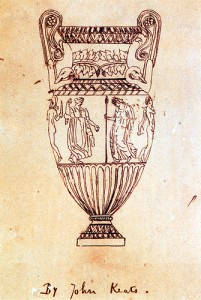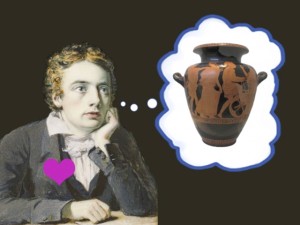You’ve probably heard of John Keats’ “Ode on a Grecian Urn” at some point in your educational lifespan. It’s the Romantic poem about an urn. Upon viewing some of the recently plundered–er, repurposed, the British government might say–goods the British army had carted back to London and put on display,

Keats was so moved by a particular urn that wrote a poem about it. Here it is in full text below, courtesy of poetryfoundation.org:
“Thou still unravish’d bride of quietness,
Thou foster-child of silence and slow time,
Sylvan historian, who canst thus express
A flowery tale more sweetly than our rhyme:
What leaf-fring’d legend haunts about thy shape
Of deities or mortals, or of both,
In Tempe or the dales of Arcady?
What men or gods are these? What maidens loth?
What mad pursuit? What struggle to escape?
What pipes and timbrels? What wild ecstasy?
Heard melodies are sweet, but those unheard
Are sweeter; therefore, ye soft pipes, play on;
Not to the sensual ear, but, more endear’d,
Pipe to the spirit ditties of no tone:
Fair youth, beneath the trees, thou canst not leave
Thy song, nor ever can those trees be bare;
Bold Lover, never, never canst thou kiss,
Though winning near the goal yet, do not grieve;
She cannot fade, though thou hast not thy bliss,
For ever wilt thou love, and she be fair!
Ah, happy, happy boughs! that cannot shed
Your leaves, nor ever bid the Spring adieu;
And, happy melodist, unwearied,
For ever piping songs for ever new;
More happy love! more happy, happy love!
For ever warm and still to be enjoy’d,
For ever panting, and for ever young;
All breathing human passion far above,
That leaves a heart high-sorrowful and cloy’d,
A burning forehead, and a parching tongue.
Who are these coming to the sacrifice?
To what green altar, O mysterious priest,
Lead’st thou that heifer lowing at the skies,
And all her silken flanks with garlands drest?
What little town by river or sea shore,
Or mountain-built with peaceful citadel,
Is emptied of this folk, this pious morn?
And, little town, thy streets for evermore
Will silent be; and not a soul to tell
Why thou art desolate, can e’er return.
O Attic shape! Fair attitude! with brede
Of marble men and maidens overwrought,
With forest branches and the trodden weed;
Thou, silent form, dost tease us out of thought
As doth eternity: Cold Pastoral!
When old age shall this generation waste,
Thou shalt remain, in midst of other woe
Than ours, a friend to man, to whom thou say’st,
“Beauty is truth, truth beauty,—that is all
Ye know on earth, and all ye need to know.”
Seems like dude was a bit obsessed with an urn, right? As easily as this poem can be written off as an exaggerated infatuation with a foreign object, let’s take a moment to think about how we interact with art. Art is generally supposed to move us in some

way. Keats, upon viewing an ancient piece of art, was moved both by the piece’s survival, the story it was communicating, and what the piece meant to him, particularly. So why do we think the poem is so off? Keats is just reacting appropriately, though maybe a bit exaggeratedly. The heightened language of Romantic literature is supposed to be dramatic, hence the feeling we modern readers get of obsessive urn love.
It’s also important to remember that Keats wasn’t a rich guy who could afford to go out and buy himself a Grecian urn to put on his mantle. He worked for a living and wrote poetry on the side, a contrast to his wealthy contemporaries like Lord Byron and Percy Bysshe Shelley. His class status was an easy target for literary critics, who heaped abuse on Keats’ poetry and even Keats himself. Their criticism created considerable stress for Keats, who was already struggling with chronic tuberculosis, and is thought to have sped up the effects of his tuberculosis—at least among modern-day romantics, he’s always said to have been killed by the critics.
So let’s cut Keats a break. His Ode on a Grecian Urn is just a reaction to a piece of art. What’s so bad about that? Keats also wrote “On Seeing the Elgin Marbles,” another reaction piece. In fact, these two poems are so well-known in their reactions to visual art that they are probably the best-known of ekphrastic poetry–ekphrastic meaning a reaction to visual art. Keats was hardly the first to write in this mode, but his perfection and popularization of the genre made his ekphrastic poems the most famous in English literature. No big deal.
Challenge: the next time you see a piece of art, try putting your feelings and musings about it into words. With meter and some sort of rhyme structure. It’s actually pretty hard!







